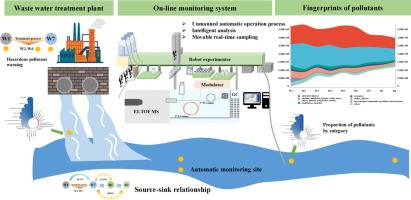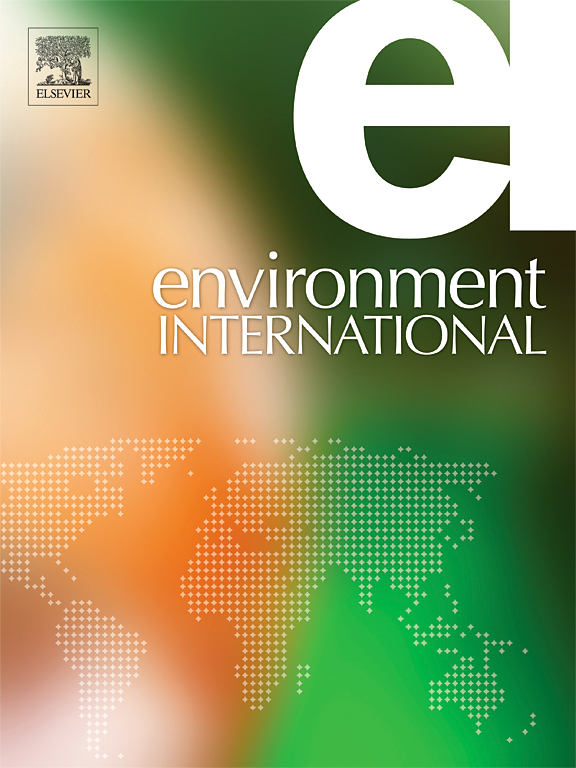Automated pretreatment of environmental water samples and non-targeted intelligent screening of organic compounds based on machine experiments
IF 10.3
1区 环境科学与生态学
Q1 ENVIRONMENTAL SCIENCES
引用次数: 0
Abstract
The complexity of environmental pollutants poses significant challenges for monitoring and analysis, especially with the emergence of numerous emerging contaminants. Traditional analysis methods rely mainly on laboratory analysis, which involves labor-intensive and time-consuming sample preparation procedures and non-target data analysis, greatly limiting the rapid detection of water organic pollutants. In this study, we designed a robot experimenter combined with GC × GC-TOFMS. By configuring self-developed automated analysis software, we established a fully automated process from sample collection to data characterization, for the analysis of organic pollutants. We validated the method with 111 organic standards compounds. The robot performed 2577 actions covering the entire workflow, from water sample collection to sample pre-treatment. The integration of mass spectrometry and related software enabled the automatic analysis of emerging hazardous contaminants, from sampling to the output of detection results. The results showed the automated process could qualitatively identify all compounds and demonstrated good linearity, low detection limits, and excellent quantitative ability within the range of 0.04–0.4 mg/L. The average recoveries of 82.89 % of the samples ranged from 70 % to 120 % (relative standard deviation (RSD) <15 %) at different spiked concentrations. This indicated that the established method could be used for non-targeted analysis of emerging contaminants in environmental water samples. We applied the method to samples from wastewater treatment plants and river sections, identifying 1,902 compounds across 26 categories, including 6 known hazardous contaminants found in all samples. The relative content of these characteristic compounds will inform whether treated wastewater meets discharge standards and aid in tracing the sources of pollutants. Therefore, the development of this fully automated machine experimental method enables real-time and online automatic analysis of organic pollutants in environmental water. The establishment of characteristic fingerprints can provide technical support for early warning and traceability of water quality.


环境水样的自动预处理和基于机器实验的有机化合物非目标智能筛选
环境污染物的复杂性给监测和分析工作带来了巨大挑战,尤其是随着众多新兴污染物的出现。传统的分析方法主要依靠实验室分析,其样品制备过程和非目标数据分析耗费大量人力和时间,极大地限制了水体有机污染物的快速检测。在本研究中,我们设计了一种与 GC × GC-TOFMS 相结合的机器人实验器。通过配置自主开发的自动分析软件,我们建立了从样品采集到数据表征的全自动流程,用于有机污染物的分析。我们用 111 种有机标准化合物对该方法进行了验证。机器人执行了 2577 次操作,涵盖了从水样采集到样品预处理的整个工作流程。质谱仪和相关软件的整合实现了从采样到输出检测结果的新出现的有害污染物的自动分析。结果表明,该自动化流程可对所有化合物进行定性鉴定,并在 0.04-0.4 mg/L 的范围内表现出良好的线性、较低的检测限和出色的定量能力。在不同的加标浓度下,样品的平均回收率为 82.89%,范围在 70% 至 120% 之间(相对标准偏差为 15%)。这表明所建立的方法可用于环境水样中新出现污染物的非目标分析。我们将该方法应用于污水处理厂和河段的样本,鉴定出 26 个类别中的 1902 种化合物,包括在所有样本中发现的 6 种已知有害污染物。这些特征化合物的相对含量将告知经处理的废水是否符合排放标准,并有助于追踪污染物的来源。因此,这种全自动机器实验方法的开发实现了对环境水体中有机污染物的实时在线自动分析。特征指纹的建立可为水质预警和溯源提供技术支持。
本文章由计算机程序翻译,如有差异,请以英文原文为准。
求助全文
约1分钟内获得全文
求助全文
来源期刊

Environment International
环境科学-环境科学
CiteScore
21.90
自引率
3.40%
发文量
734
审稿时长
2.8 months
期刊介绍:
Environmental Health publishes manuscripts focusing on critical aspects of environmental and occupational medicine, including studies in toxicology and epidemiology, to illuminate the human health implications of exposure to environmental hazards. The journal adopts an open-access model and practices open peer review.
It caters to scientists and practitioners across all environmental science domains, directly or indirectly impacting human health and well-being. With a commitment to enhancing the prevention of environmentally-related health risks, Environmental Health serves as a public health journal for the community and scientists engaged in matters of public health significance concerning the environment.
 求助内容:
求助内容: 应助结果提醒方式:
应助结果提醒方式:


